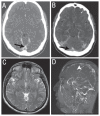Spectrum of Cerebral Venous Thrombosis in Oman
- PMID: 30607274
- PMCID: PMC6307648
- DOI: 10.18295/squmj.2018.18.03.011
Spectrum of Cerebral Venous Thrombosis in Oman
Abstract
Objectives: Cerebral venous thrombosis (CVT) can have varied and life-threatening manifestations. This study aimed to examine the spectrum of its clinical presentations and outcomes in a tertiary hospital in Oman.
Methods: This retrospective study was conducted at the Sultan Qaboos University Hospital, Muscat, Oman, between January 2009 and December 2017. The medical records of all patients with CVT were reviewed to determine demographic characteristics, clinical features and patient outcomes.
Results: A total of 30 patients had CVT. The mean age was 36.8 ± 11 years and the male-to-female ratio was 2:3. Common manifestations included headache (83%), altered sensorium (50%), seizures (43%) and hemiparesis (33%). Underlying risk factors were present in 16 patients (53%). Computed tomography or magnetic resonance imaging of the brain was abnormal in all patients, with indications of infarcts (40%) and major sinus thrombosis (100%). There were five cases (20%) of deep CVT. The patients were treated with low-molecular-weight heparin, mannitol and anticonvulsants. The majority (77%) had no residual neurological deficits at follow-up.
Conclusion: These findings indicate that CVT is a relatively uncommon yet treatable disorder in Oman. A high index of suspicion, early diagnosis, prompt anticoagulation treatment and critical care may enhance favourable patient outcomes.
Keywords: Cerebral Thrombosis; Cranial Venous Sinuses; Neurological Manifestations; Oman; Patient Outcome Assessment; Venous Thrombosis.
Conflict of interest statement
CONFLICT OF INTEREST The authors declare no conflicts of interest.
Figures




Similar articles
-
Outcomes and complications of patients with cerebral venous thrombosis: a retrospective study.Neurosciences (Riyadh). 2024 Jan;29(1):32-36. doi: 10.17712/nsj.2024.1.20230050. Neurosciences (Riyadh). 2024. PMID: 38195128 Free PMC article.
-
Clinico-epidemiological profile & outcome of patients presenting with cerebral venous thrombosis to emergency department.Am J Emerg Med. 2024 Nov;85:65-70. doi: 10.1016/j.ajem.2024.08.034. Epub 2024 Sep 2. Am J Emerg Med. 2024. PMID: 39241293
-
Headache as the only neurological sign of cerebral venous thrombosis: a series of 17 cases.J Neurol Neurosurg Psychiatry. 2005 Aug;76(8):1084-7. doi: 10.1136/jnnp.2004.056275. J Neurol Neurosurg Psychiatry. 2005. PMID: 16024884 Free PMC article.
-
Cerebral venous sinus thrombosis: update on diagnosis and management.Curr Cardiol Rep. 2014 Sep;16(9):523. doi: 10.1007/s11886-014-0523-2. Curr Cardiol Rep. 2014. PMID: 25073867 Review.
-
Venous thrombosis of the brain. Retrospective review of 110 patients in Kuwait.Neurosciences (Riyadh). 2014 Apr;19(2):111-7. Neurosciences (Riyadh). 2014. PMID: 24739407 Review.
Cited by
-
Recurrent Idiopathic Cerebral Venous Thrombosis.Cureus. 2025 Jun 16;17(6):e86167. doi: 10.7759/cureus.86167. eCollection 2025 Jun. Cureus. 2025. PMID: 40677504 Free PMC article.
-
Outcomes and complications of patients with cerebral venous thrombosis: a retrospective study.Neurosciences (Riyadh). 2024 Jan;29(1):32-36. doi: 10.17712/nsj.2024.1.20230050. Neurosciences (Riyadh). 2024. PMID: 38195128 Free PMC article.
-
Characteristics and Outcomes of Patients with Cerebral Venous Sinus Thrombosis.Oman Med J. 2019 Sep;34(5):434-437. doi: 10.5001/omj.2019.79. Oman Med J. 2019. PMID: 31555420 Free PMC article.
References
-
- Narayan D, Kaul S, Ravishankar K, Suryaprabha T, Bandaru VC, Mridula KR, et al. Risk factors, clinical profile, and long-term outcome of 428 patients of cerebral sinus venous thrombosis: Insights from Nizam’s Institute Venous Stroke Registry, Hyderabad (India) Neurol India. 2012;60:154–9. doi: 10.4103/0028-3886.96388. - DOI - PubMed
MeSH terms
LinkOut - more resources
Full Text Sources
Medical
